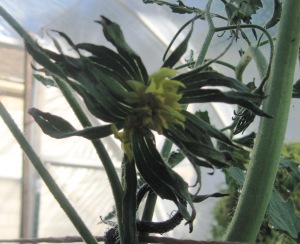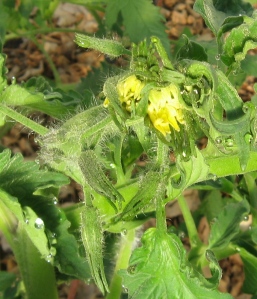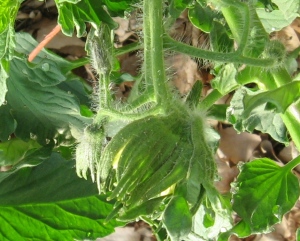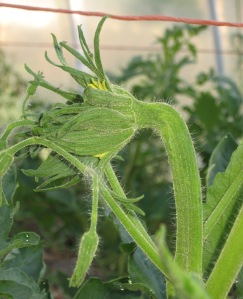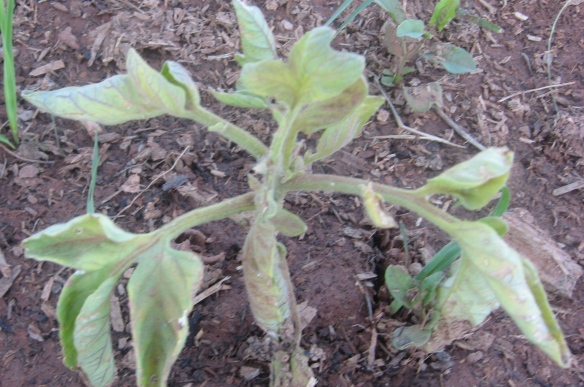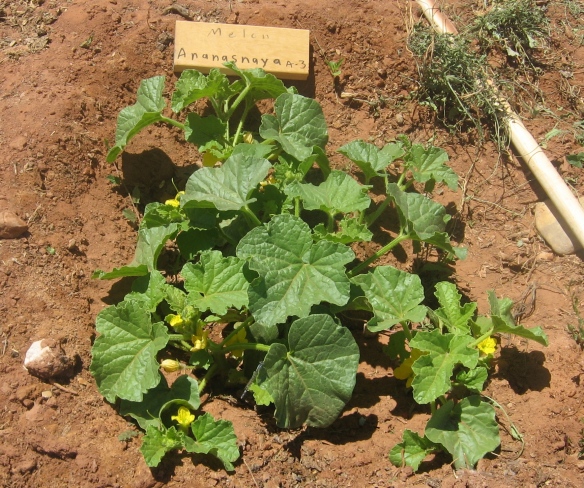By any measure, tomato vines in the backyard high tunnel are doing much better than those in the giant tomato bed in the front yard.
Here’s a comparison of leaves of “Russian” vines, a wispy-, regular-leaf variety which produces heart-shaped fruit. Note that both vines were grown from seeds of the same specimen (2.319 DT 2010).
Tunnel:
Giant Tomato Bed:
Here are some measurements which really emphasize differences between these two plants with identical genetics; all measurements are of the largest leaf or leaflet and are in mm (millimeters):
MEASUREMENT GIANT TOMATO BED HIGH TUNNEL
Plant Height 855 1082
Thickest Stem 11.2 19.6
Longest Leaf 242 374
Longest Leaflet 104 210
Widest Leaflet 41 84
All varieties are showing this stark contrast. Treatment differences are discussed at:
http://tomatodepot.proboards.com/thread/5281/induce-megabloom-production?page=1&scrollTo=69304
Some impressive megablooms are starting to open in the high tunnel!
Here are some triples (3X) –
Polish Giant Beefsteak (2.222 DT 2013):
Big Zac (3.486 DT 2012)(3.94 Pennington 2010)(7.18 Harp 2009):
A few 4X’s –
Russian (2.319 DT 2010), with sepals measuring 3-1/2″ across:
Domingo (4.55 Wahl 2012):
Big Zac (4.57 MacCoy 2013)(5.07 Boudyo 2010):
Chilo della Garfagnana (3.375 Koshykar 2012):
And some 5X’s –
Omar’s Lebanese (1.724 DT 2010):
Belmonte (1.556 DT 2011)(4.14 Perry 2009):
Brutus Magnum (2.006 DT 2012)(6.25 Meisner 2011):
And some which even appear to be 6X (admittedly usually tough to tell beyond 4X or so) –
Big Zac (3.75 Catapano 2007)(4.59 Lyons 2006):
Leadbeatter’s Lunker (1.644 DT 2012)(4.905 Leadbeatter 2012):
Epstein’s Potato Leaf (__Johnson 2012)(Big Zac derivative):
Rebecca Sebastian’s Bull Bag (2.200 DT 2010):
And yes, even a 7X –
Porterhouse (F2)(2.062 DT 2011):
And last, but not least, an 8X!
Michael’s Portuguese Monster (2.610 DT 2012):
This megabloom has 38 distinct sepals, compared to 6 or 8 on other blossoms on this vine.
Note that several of these megablooms emerge from “ribbon” vines; that is, multiple fused vines which are quite flattened. In the world of giant pumpkin growing, ribbon vines are duds. I don’t recall this phenomenon producing anything remarkable with tomatoes either, but my sample size is small and my memory inadequate.
The huge challenge at this point is to find enough viable pollen needed to get these impressive blossoms to set fruit. Western Flower thrips (Frankliniella occidentalis) are running rampant, gobbling up the pollen before it even matures. At least the weather has been cooperating – so far not nearly so hot as 2012 and 2013.
PS –
Here’s what I posted at The Tomato Depot on June 17th in the thread “Induce Megabloom Production”:
As those who have tried to grow giant tomatoes can attest, regardless of genetic stock, you really need fused ovaries (manifested as megablooms) in order to grow giant tomatoes. Though some have claimed to grow 4, even 5 pound tomatoes from a single ovary (blossom), upon careful inspection, these would almost always be the result of tightly fused fruits. Usually with the really big tomatoes, it’s quite obvious from deep lobing and weird shapes that they emerged from megablooms.
So in our quest for the 8-pounder, an enticing question is:
What, if anything, can we do to induce the production of megablooms?
There has been some discussion of this in the “New thoughts on that elusive 8lb’er” thread, as well as the “mega bloom varietys???” thread.
I have not stumbled upon any genuine research into this question, but several have made observations and conjecture. This issue has come into sharp focus for me in the past few days. I have two garden beds in production for large (hopefully giant) tomatoes. Here is a summary of the differences.
Parameter Giant Tomato Bed Backyard High Tunnel
Size of bed 33′ X 7′ 27′ X 6′
No. tomato plants 24 36
Walking path Down middle, boards Outside bed
Sunlight Full sun Sun only 11 am – 5pm
New organic matter 6″ 4″
Other nutrients Lots Not as much but a lot
How long as garden 3 years 40 years
Date seeds planted March 25 April 05
Date transplanted May 21 May 22
Watering method Sprinkling Buried soaker hose
Surface cover Wood chips & leaves Leaves
First blossoms open May 24th June 17th
What has me intrigued is the stark contrast in megablooms – or rather “megabuds” in formation, since most are in earlier stages of development. Here is a comparison of the best megabloom/megabud between these two beds.
Best/Biggest Blossom Giant Tomato Bed Backyard High Tunnel
1X 14 6
2X 4 7
3X 2 10
4X+ 2 8
None yet 2 5
Total 24 36
Here, “3X”, for example, means a triple, or three fused blossoms, and raw numbers indicate the number of tomato plants with that size of “best/biggest” blossom.
The contrast is sharp – plants are doing much better in the high tunnel, at least as far as megabloom production. What is also noteworthy is that in the giant tomato bed, both 4X+ blossoms withered and died, despite my best efforts to pollinate. Also, one of the 3X’s died. The other 3X (on a MegaMarv) took and is growing fairly well, though it has some catfacing. Despite 100+ blossoms that have opened in the past couple of weeks in the giant tomato bed – nearly all singles – only this one MegaMarv has set fruit.
Yes, it is early in the season, but these preliminary observations raise several questions about what might be involved in inducing megabloom production.
What has worked for you? How much, if any control do we have to stimulate production of those coveted 6X or 8X blossoms? Has anyone compiled a list of all the potential factors involved in this megabloom phenomenon? How would we distinguish a genuine cause-effect relationship from a mere correlational observation?







